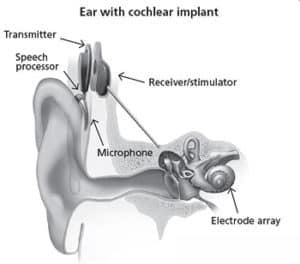Contents:
- Medical Video: During cochlear implant surgery
- What is a cochlear implant?
Cochlear implants placed in the ear Source: nidcd.nih.gov The cochlear implant consists of several parts, namely:
- Microphone which functions to take sound from the surrounding environment
- Sound processor function to select and arrange the sound taken by the microphone
- Transmintter and receiver / stimulator receive signals from the sound processor and turn them into electrical impluls
- Electrode array, is an arrangement of electrodes that serves to collect impulses from the stimulator and send them to the auditory nerve
- Who needs to use cochlear implants?
- Are there risks that might occur when using a cochlear implant?
Medical Video: During cochlear implant surgery
For people who have hearing loss, the use of hearing aids will greatly help smooth daily activities. One hearing aid that can repairmoderate to severe hearing loss, even deafness, is a cochlear implant. If you are considering using a hearing aid, it's good to first read the full information about cochlear implants and how they work, and what distinguishes them from the hearing aids that you normally encounter.
What is a cochlear implant?
A cochlear implant is a small electronic device that is placed in the ear of a person who has hearing loss. AThis lat helps users better understand the sound or conversation that is happening.But hearing through a cochlear implant will be different from how you hear it normally, so it takes time to digest again.

The cochlear implant consists of several parts, namely:
- Microphone which functions to take sound from the surrounding environment
- Sound processor function to select and arrange the sound taken by the microphone
- Transmintter and receiver / stimulator receive signals from the sound processor and turn them into electrical impluls
- Electrode array, is an arrangement of electrodes that serves to collect impulses from the stimulator and send them to the auditory nerve
What's the difference with ordinary hearing aids?
Unlike hearing aids that help make the sound from the outside more loud to be heard, the cochlear implant functions to replace the damaged inner (cochlear) function of the voice to deliver sound signals to the brain. In other words, the cochlear implant helps you hear.
The cochlea or commonly called a cochlea organ functions to take sound vibrations and send them to the brain via the auditory nerve. When the cochlea is damaged, the sound will not be able to reach the nerve so that the brain cannot process the signal as sound. The implant function delivers sound to the auditory nerve to get back up.
Who needs to use cochlear implants?
Children and adults who experience hearing difficulties or even severe deafness can use this implant.
This tool is safe for use even by children at least 12 months. A research cited by the US National Institute of Health proves that cochlear implants that are installed before 18 months of age can make children hear better, understand various sounds and music, even talk to their friends when they grow up.
Furthermore, children who have difficulty hearing and using impan can even develop language skills comparable to children whose hearing is normal. In fact, they can attend school well in ordinary schools. Of course this really helps them in living their lives.
Adults who have hearing loss can also be very helpful because of this tool. They will try to match the sound they are hearing now with the sound they once heard, including the conversation of people, without having to see the other person's lips.
Are there risks that might occur when using a cochlear implant?
Just like other medical devices, there are several risks that might occur when you use an implant. This includes:
- Auditory nerve injury
- Numbness around the ears
- Dizziness and problems with balance or vertigo
- Ringing ears (tinnitus)
- Cerebrospinal fluid leakage
- Infection of the area around the machine, so that the implant that has been installed must be removed
- Infection of the lining of the brain or commonly called meningitis
But not necessarily everyone who uses the cochlear implant will experience this. Please consult a specialist doctor about possible risks above, especially for your condition.












